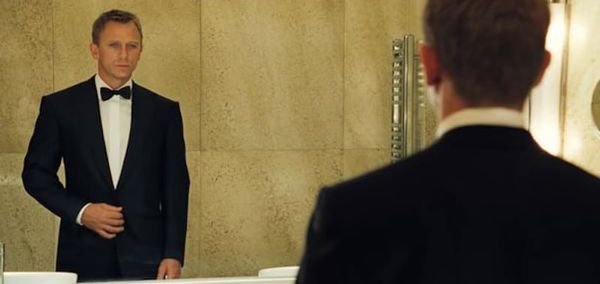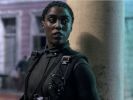Eye For Film >> Movies >> No Time To Die (2021) Film Review
No Time To Die
Reviewed by: Andrew Robertson

Not as much of a retrospective as Skyfall nor a parts-bin special like Spectre, this still borrows heavily from the accoutrements of the previous films and, though inevitably moving the franchise forward, has an eye on the rear view mirror. This includes the pre-credit sequence, one that starts in a flashback. The beginning is itself an end, or at least the beginning of an end.
Eye For Film saw it at a (very) early morning screening, ten past midnight. For want of three minutes the ticket might have read 0:07 but we might be alone in that desire. We weren't quite alone in the audience either, but even across four screens the numbers we saw were in the scores rather than throngs. It's hard to judge between Covid and it being a school night, but it felt more akin to Solo than any other clock-beating booking. No Time To Die might not save cinemas, but it will keep Bond going.

There's the usual international jaunting, a Jamaican idyll is as close to Fleming's Goldeneye home as anything else we've seen. There's Norway, Cuba, London naturally, plenty of Italy too. The Faroe Islands are called to fill in for the Kuriles, or at least some other disputed archipelago between Russia and Japan. This geographic sleight of hand seems to exist more to justify set design than due to any political complexities or force projection to a part of the globe that was never properly pink.
This includes a bad guy lair that borrows heavily from modernist Japanese and brutalist Soviet aesthetics, almost inevitably stealing from Eighties futurist sensibilities like tears in the rain. It's MUJI by way of CCCP, mandarin collars and Acronym hype drops. There's even a "big plane", and a bad guy helicopter, though this one doesn't have the same "Boom Boom" (Animals) as previous choppers. The score could at times be described as overbearing, but that's a feature of Bond. Hans Zimmer takes his turn working around that iconic theme, but it's not just that returning from previous films. All the time in the world wouldn't be enough to fit in every previous Bond theme, but it would seem there can't only be one.
Cary Joji Fukanaga directs. This is only his fifth feature by my count though he's helmed series of Maniac and True Detective. There are some stylistic flourishes in and amongst flashes of blockbuster cliché, the reflections in the title sequence's rifled barrel and that sequence's reflection in a tunnel shot are striking. It's co-written with Neal Purvis and Robert Wade, their seventh Bond film. While it's been widely reported that Phoebe Waller-Bridge was called in to punch it up, the mark of their comedy chops is perhaps that they're also responsible for Plunkett & Macleane and Johnny English. Not all brutal killings are met with a quip. Some might log a complaint but the decision will have its defenders. Harder, perhaps, to justify is yet another plot that is dependent on a dead mother or two.
Wade and Purvis' nods to their own work extend beyond the spectre of Spectre, the notion that repeating a character's name often enough will give it dramatic import, some actually verge on subtlety. Foxgloves are the source of digitalis, and that mixture of the programmable and the poisonous drives much of the plot. Driving, that is, when not done behind the wheel of a pair of previously seen Aston Martins, or the concept hypercar Valhalla. Not the only mythological reference, there's a Heracles, but it'd be labouring the point to wonder if it's for soothing snakes or infanticide that the McGuffin was named.
I'd mention Ouroborous if only for the sense of devouring its own tail. This is an ending to Daniel Craig's Bond, and undoubted at that. There's still that text after the credits, however: James Bond will return. We will see how, eventually. As it stands this is the 25th Bond Film, 2021 is 68 years after Fleming's first publication, 59 after the first film. It is also very definitely Craig's last, but one's satisfaction with that conclusion may vary.
Craig's been Bond five times, one more than Brosnan, par with Connery depending on how the Thunderball lies, not more than Moore, two fewer, but that's not the whole of it. Moore was only in the sight picture for 12 years to Craig's 15, despite the two film advantage they last just less than an hour more. By most measures he's the longest incumbent or a second in the duel, and there's a weight to that. One felt in the 163 minute run-time, though it usually passes without notice. There is one sequence though with yet another captured conspirator where something advances with a literal mechanical inevitability.
The Craig Bonds are filled with reflections. Not just what James Jesus Angleton, real-life CIA counterintelligence chief called "the wilderness of mirrors" but other versions of Bond. Here not just other double-oh-agents, but orphans, assassins, counterparts and counterpoints. Within this opposite of opposite sits our antagonist (Rami Malek), though at times one wonders if he is meant to be Waluigi or Bowsette. Some of these moments are as subtle as the kind of stationery M fidgets with before a particular portrait, others as open as people saying they are the same as each other.
Ranulph Fiennes returns, and for some sequences might have given Malek tips from Voldemort's big book of interacting with children. The big book of bad guy names has been called into play too, Lyutsifer Safin isn't quite Cruella DeVille but it doesn't take a lot to cast it in a troublesome light. Ben Wishaw too, though Q representation might be off the menu. There's a lot of being looked at looking at screens, and they and Naomi Harris' Moneypenny and Rory Kinnear's Tanner have a lot of remote emoting. More in the field is Lashana Lynch's Nomi, sufficiently suave and skilled that when she's described as 'disarming' I had to check that she hadn't literally removed a limb.
Ana De Armas has a very different chemistry with Craig than in Knives Out, but it works nonetheless. Lea Seydoux returns as Madeleine Swann, and it's her history with and outwith Bond that drives much of the conflict. Jeffrey Wright is as usual a delight as Felix Leiter, though here his honourable veteran is joined by the schoolboy Logan Ash (Billy Magnussen). Referred to as "The Book of Mormon", it's a funny line, but the explanation for his presence misses the chance to highlight that the Church is (at least allegedly) disproportionately represented within America's intelligence and investigative agencies.
There are a lot of gadgets, zip-lines, grenade launchers, watch out for a watch. That intermediate base is helpfully lit with teal and orange fluorescent strips. There are some real colours too, there's clearly loads of Monet in the budget. In one element of the extended mission infiltrators are represented with Greek letters in mandarin and azure. That one is 'psi' is spoken aloud, that the other is 'phi' is a joke I'm sharing with you. There's a witticism that a technothriller is just science fiction with the President in it, here instead it's the PM.
There's some novelties here. A Bond film depicting an espresso machine in the home was once futuristic, here a Tamagotchi and box-wine are meant to root us in the past. In the same way that we know the Bond films exist in the MCU thanks to Black Widow, we've evidence that Wallace & Gromit exist in the Bond films. Disappointingly, nobody else puts on the wrong trousers, but there are definitely moments where things have gone wrong. Feathers McGraw is not the only one in the film to have a form of telepresence, though his is perhaps more eye-catching.
Yet for all that flashbang and whizzbang the core of Craig's tenure has always been an emotional Bond. We've had a movement from the parkour of Casino Royale to a properly post-John Wick speed and lethality, but those big blue eyes still crinkle at the corners. One could drown in a sea of those tears, and there is time enough to let this last outing wash over you.
It is not without sticking points. Logistics alone, with the usual bumpf of cinema advertising (and perhaps the trailer for House Of Gucci) it pushes well past three hours of one's life. Within the near dozen action sequences, all thrilling, some might be redundant. The shadowy figures in an opening raid are all cloak and coherent light, but the frequent presence of foreshadowing for a particular piece of equipment is undermined by it being a key part of the trailer. There's a bit of text quoted, but it's Jack London. For sure it's a good one, even espoused in the semi-autobiographical Martin Eden, but despite his pseudonym and his world travels John Griffith Chaney was an American. Surely somewhere in the canon of English literature there was some means to hit a similar target?
Elsewhere there's talk of a curse, and it is true that in the valley Bond and his ilk walk there is more than a shadow of death. There are also plenty of echoes, the card counting of predictability even to the clues in the opening titles. There's a suggestion that it's impossible to be clean, to borrow from another Scot that "all the perfumes of Arabia will not sweeten". Too that "every noise appals", there are two moments of simulated post-explosion deafness that may be traumatic to audiences. A flashing sequence or two too, but as with that satsuma and cerulean these are perhaps consequences of modern film-making. The products placed are perhaps more of Bond, the irony of the statement about the credits of no consideration for tobacco when there are jokes about drinking and one lull in shooting is broken by shots.
That difficulty of cleanliness though is one of many challenges taken on within the film. In trying to draw a line under this iteration it could have tied itself in knots. While it does not always unfurl gratefully, the hangman's hands let slip the noose. Those unclean hands do not so much the multitudinous seas incarnadine as get us to a tabula rossa. James Bond will return, just not this one. That there's a Madeleine would be an excuse to indulge in the Proustian, but for all the symbols and significance this is only philosophical at the surface. Suffice to say that No Time To Die is not just a goodbye, but an au revoir.
Reviewed on: 30 Sep 2021


















